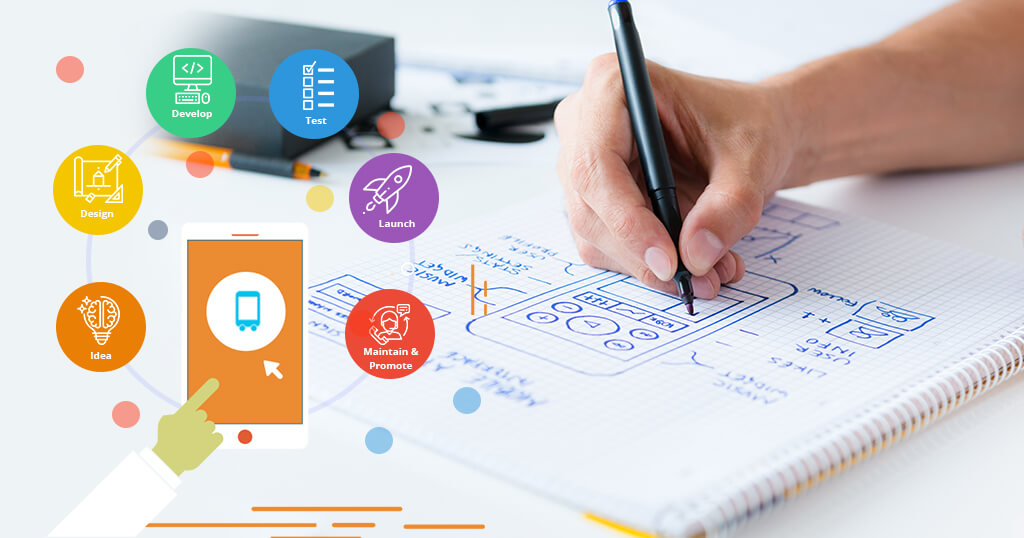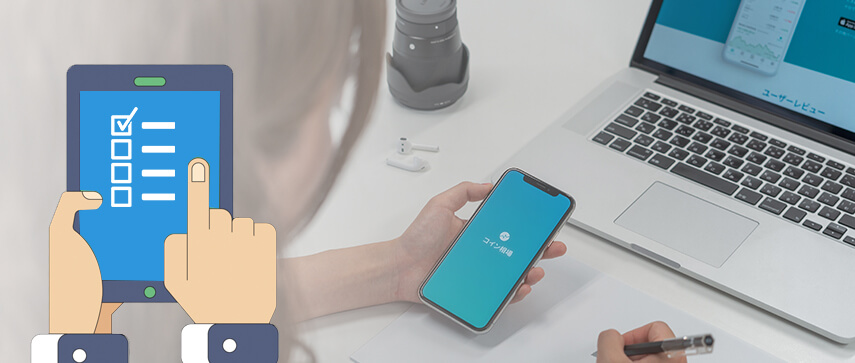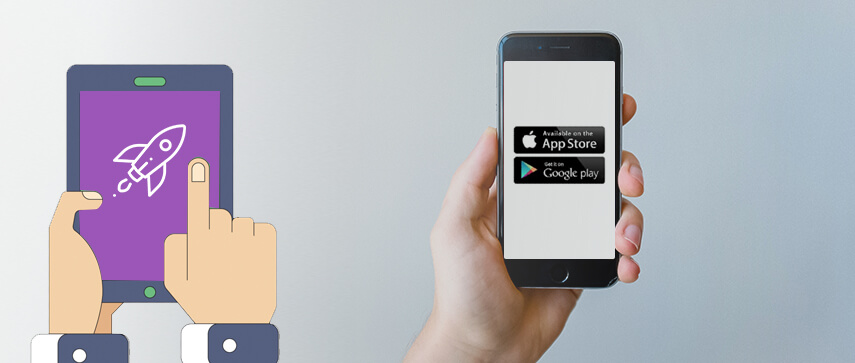Smartphones are continuously transforming the way we do business. From booking a travel ticket and taking online health consultations to food ordering and making bill payments, mobile applications help us perform multiple tasks conveniently and efficiently.

Currently, there are 7.1 billion smartphone users worldwide and it is likely to rise in the coming years. And the same goes for mobile applications. The global mobile application market shall witness an upliftment of $653.91 billion during 2021-2025 with a progression of almost 21% CAGR during the forecast period.
As such, having a mobile app has become the need of the hour for businesses across the globe. It increases brand awareness, improves customer engagement, drives revenue, growth, and much more. However, most businesses are unaware of the right mobile app development process to convert their app into a full-fledged market-ready product.
Therefore, we have broken down the entire mobile application development lifecycle into seven steps to help you create a niche and build an enterprise-grade application that your customers shall love.
How to Build a Successful Mobile App in 7 Easy Steps?
You need to follow the right set of steps for completing your mobile app development project within stipulated timelines. Many companies tend to ignore these steps and have to deal with various challenges at every development stage. Not to worry, here’s a clear depiction of the process you can count on.
Step 1: Ideation and Product Discovery
Before you start your mobile app development, you need to do a proper market study around your idea or concept to identify the viability of your overall project. This stage not only discovers new ideas and solutions but also comes up with the list of requirements needed to satisfy the project scope. It’s a constant brainstorming imperative to adapt your idea to the end user’s needs.
Having clear answers to the following questions upfront shall go a long way in ensuring the success of your product discovery.
- End Goal: What is the purpose of your app? How is it going to impact your user base in the long run? Which specific problems your app aims to solve?
- Target Audience: Who is the target audience? Who are the potential users? What kind of problems do they have?
- App USP: What features are most important for the mobile app? What features should help it stand out in the market? What is your app’s core appeal?
- Target Platforms: What Mobile OS platforms shall you build the app for? Should you go for Native or Cross-platform or Hybrid?
- Market Analysis: What type of app are your competitors using? What distinctive features have they included in their app? How did they plan the development process?
- App Expenditure: What is your app development cost structure? How are you going to distribute the expense across the development stages?
- App Timeline: When are you planning to launch your app into the market? What is your mobile app development timeline? How shall you determine if the goal has been met?
- App Promotion: What is your app marketing strategy? Which modes of advertising your mobile app shall need the most?
- Post-launch Support: What shall be your take on regular app updates? What plan of action your development team shall adopt to fix bugs and improve engagement?
Step 2: Strategy and Product Planning
This is one of the most important app development stages where you can transform your idea into a live project. You need to have a robust long-standing strategy and planning, to define use cases and capture detailed functional requirements.
- Product Roadmap: First, start with the visualization of the mobile app development strategy, called a product roadmap. It outlines the key points such as vision, mission, strategy, product features, time frame, technology, team, etc., in a document for better and timely execution.
- Product Structure: You can also establish your minimum-viable product (MVP) and stir the initial launch if budget, resources, or time frame is an issue.
- Product Team: The mobile app strategy and planning stage also demands identifying the skills required for your project. For instance, Android and iOS platforms both use different tech stacks. If you aim for an app compatible with both platforms, then make sure you have Android as well as iOS developers in your mobile development team.
Step 3: Mobile App Design – UI/UX Designing

The user interface (UI) and user experience design (UX) are two important factors that determine the success of any mobile app design process. A great UI focuses on the looks of an app, while UX design speaks about multiple aspects of human interaction with the app such as branding, usability, function, etc. this stage includes multiple aspects, as discussed below.
- User Journey Map: It’s all about representing the user’s experience. Your development team should prepare this journey map to depict the user flow through your mobile application. It helps in creating a good UI with minimalistic features.
- Wireframes: User interface design for any mobile app development process is called a wireframe. It is one kind of pictorial depiction that presents key elements of the UI such as buttons, fields, layout, icons, etc. It provides a visual idea of the app with salient details like the size of the elements and their placement. Wireframes are mainly focused on aesthetics, layout details, and user experience.
- Style Guide: A style guide provides the details of various app functions, without which developing a high-quality app can be less efficient. Standardization of UI elements, UI frames and end-to-end experience, consistency in the use of intuitive UI elements, usability-driven process flow, and uniformity/uniqueness of the app are some of the factors that are achieved by style guides.
- Mockups: It can be defined as the rendering of the app’s visual design. Here, the wireframes combine with style guide design standards and provide the interconnection between various elements of visual design, thus establishing the flow of the app. Also known as high-fidelity design, a mockup successfully demonstrates how the app functions. Adobe Photoshop and Sketch are two popular tools for creating high-fidelity mockups.
- Prototypes provide: a glimpse into how your mobile app works. They are specifically required if the technology is new, concepts are not tested or there is uncertainty about the app development. They can be even used to create a demo version of your mobile app. Prototypes also help in understanding the visual interface, user experience, and workflow to develop a user-friendly mobile app.
Step 4: Mobile App Development

This step-by-step app development covers the actual realization and coding of your app. A typical mobile app development project requires developing code and configuring it for these parts.
- Back-End/Server Technology: You need to have the right back-end platform to support the functionalities of your application. Even if you’re using an existing platform, make sure it assists modifications and configurations. The server-side objects built during this step must be thoroughly tested with various components of the app.
- Application Programming Interface (API): It’s a software intermediary that helps interconnecting not only the app and the back-end server/database but also aligns with the OS components and existing software tools/systems.
- Mobile App Front-End: It’s significant to have a strong front-end as it impacts user engagement. The front-end technology should have the best APIs to download in order to help users in connecting with a network even when offline. The technology should also manage data efficiently.
- Programming Language and Database: You need to decide the mobile app development approach either hybrid or native. Both use different languages. e.g. native mobile apps run on specific operating systems such as Android and iOS. And both these systems have different programming languages. To build Android apps, you need programming languages like C++, Java, or Kotlin; on the other hand, Objective-C or Swift languages are used for developing iOS app development.
- Frameworks, Libraries, and SDKs: The right framework choice shall help in exploiting code and satisfying unique project requirements. Your developers also need to choose a code architecture – MVC, MVP, Clean Swift, etc. Besides, software development tools and In-built & third-party libraries are necessary for your mobile app development.
- Integrated Development Environment (IDE) and Code Editor: You need to set up your project in an IDE or code editor that helps you write crisp and error-free code. For instance, XCode for iOS Apps and Android Studio for Android Apps. Exterior software development kits and libraries also play a vital role in optimizing the code.

Step 5: Mobile App Testing and QA

After completing the above milestones, the developers should pass on the app to the testing team for quality check and fixing bugs. Testing is another important stage in the mobile app development process that may overlap with the development stage in many ways and depends on the way the development is planned and executed. For example, in agile methodology, every sprint or iteration could have a testing phase.
Mobile app testing comprises of:
- Functionality Testing: It’s performed to ascertain if the functional requirements that are listed in the discovery phase are met.
- Performance Testing: It establishes performance capabilities such as touch response, average connection time, and other significant metrics.
- Security Testing: It helps to avoid security vulnerabilities, secures server-side controls, and outlines authentication of login credentials.
- Manual Testing: This involves in-detail use cases and information related to prevailing errors put forth by QA experts.
- Automated Testing: It automatically checks if any new features/functionalities are hampering the existing ones via analyzing static codes and UI integration.
After successful completion of all the above-mentioned tests and removal of in-app bugs, you can now take the approval of your client/project manager and prepare for the launch.
Here’s are some good practices that you can follow to boost your robust testing and QA environment:
- Have a separate team for QA
- Make sure that bugs are being checked for all stages of app development
- Test the mobile app for various mobile devices
- Follow strict testing guidelines and standards
- Only use QA and testing tools recommended by professionals
Step 6: Mobile App Deployment and Launch

Analyzing meticulous details of this stage is really important to efficiently market your mobile app. Ensure that you are ready with your backend deployment before publishing the app on different app stores for downloading. Launching a minimum viable product (MVP) or a beta version among your in-house team and taking genuine feedback can be a great idea.
But if you want to launch your app as a market-ready product, then you should publish it on Google Play/ Apple store. Launching it on an enterprise app store can also be a good idea if your app only aims to cater to the business world. Just make sure you meet the guidelines of the chosen app store.
Step 7: Mobile App Maintenance & Support

When regular app downloads and installations for your app speed up, there are chances that you identify some inefficiencies or want to add a new feature/ functionality to match user requirements.
Take a note of all the app’s statistics and market trends by which you can plant a good app maintenance services team to improve performance.
Apart from all this, the success of your mobile app greatly depends on the marketing strategy you implement (offline and online). You can approach a marketing professional or an experienced advertising agency to maximize your app reach and target a larger audience. Just make sure to define your end goals in the first place and choose the right marketing strategy for satisfying all the stakeholders in the longer run.
Wrapping Up
The mobile app development process can be quite overwhelming and tedious. But you cannot neglect the fact that every mobile app needs a systematic and definite approach to win a competitive edge. Therefore, following the right process becomes a necessity rather than a choice. That’s why, with years of experience in developing mobile apps for both enterprises and startups, our experts came up with the above steps to make your app a huge success.We have written an article series describing every seven steps of the mobile app development process.

Author's Bio

Nitin Lahoti is the Co-Founder and Director at Mobisoft Infotech. He has 15 years of experience in Design, Business Development and Startups. His expertise is in Product Ideation, UX/UI design, Startup consulting and mentoring. He prefers business readings and loves traveling.









